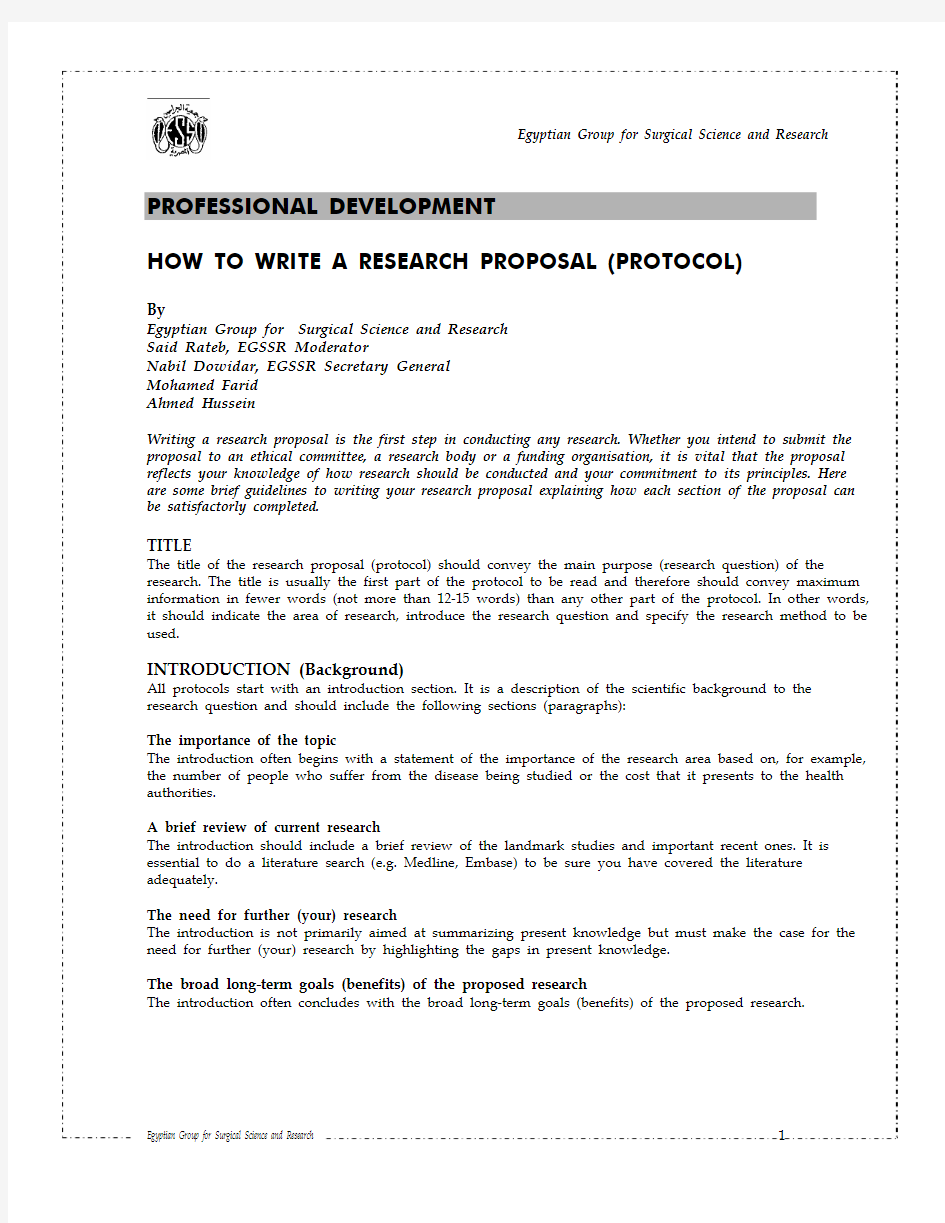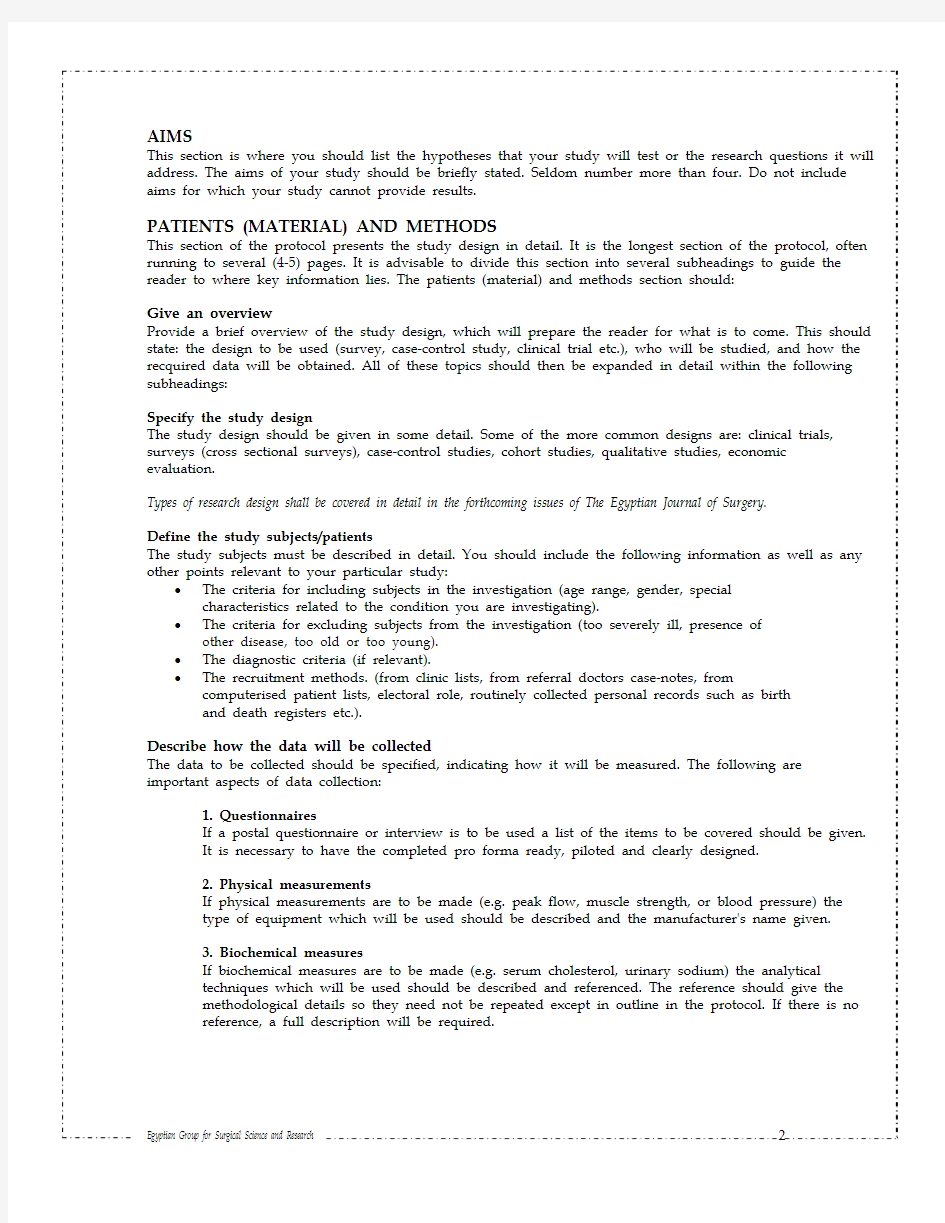

PROFESSIONAL DEVELOPMENT
HOW TO WRITE A RESEARCH PROPOSAL (PROTOCOL)
AIMS
This section is where you should list the hypotheses that your study will test or the research questions it will address. The aims of your study should be briefly stated. Seldom number more than four. Do not include aims for which your study cannot provide results.
PATIENTS (MATERIAL) AND METHODS
This section of the protocol presents the study design in detail. It is the longest section of the protocol, often running to several (4-5) pages. It is advisable to divide this section into several subheadings to guide the reader to where key information lies. The patients (material) and methods section should:
Give an overview
Provide a brief overview of the study design, which will prepare the reader for what is to come. This should state: the design to be used (survey, case-control study, clinical trial etc.), who will be studied, and how the recquired data will be obtained. All of these topics should then be expanded in detail within the following subheadings:
Specify the study design
The study design should be given in some detail. Some of the more common designs are: clinical trials, surveys (cross sectional surveys), case-control studies, cohort studies, qualitative studies, economic evaluation.
Types of research design shall be covered in detail in the forthcoming issues of The Egyptian Journal of Surgery. Define the study subjects/patients
The study subjects must be described in detail. You should include the following information as well as any other points relevant to your particular study:
?The criteria for including subjects in the investigation (age range, gender, special characteristics related to the condition you are investigating).
?The criteria for excluding subjects from the investigation (too severely ill, presence of other disease, too old or too young).
?The diagnostic criteria (if relevant).
?The recruitment methods. (from clinic lists, from referral doctors case-notes, from computerised patient lists, electoral role, routinely collected personal records such as birth
and death registers etc.).
Describe how the data will be collected
The data to be collected should be specified, indicating how it will be measured. The following are important aspects of data collection:
1. Questionnaires
If a postal questionnaire or interview is to be used a list of the items to be covered should be given.
It is necessary to have the completed pro forma ready, piloted and clearly designed.
2. Physical measurements
If physical measurements are to be made (e.g. peak flow, muscle strength, or blood pressure) the type of equipment which will be used should be described and the manufacturer's name given.
3. Biochemical measures
If biochemical measures are to be made (e.g. serum cholesterol, urinary sodium) the analytical techniques which will be used should be described and referenced. The reference should give the methodological details so they need not be repeated except in outline in the protocol. If there is no reference, a full description will be required.
Outline the study procedures
The logistics of research studies often need careful planning. Funding and evaluating committees want to know that the following sorts of questions have been addressed and answered:
?How subjects will be identified and contacted?
?What sampling methods will be used?
?Where will subjects be interviewed?
?How will the interviews be organised?
?Who will carry out the interviews?
?How will the interviewers be trained?
Some studies involve following patients over time and these need to describe how follow-up contacts will be organised. For randomised controlled trials, the method of randomisation must be described.
Describe sample size calculation
Formal sample size calculations are required for all research studies. These indicate how many study subjects are needed so that, if the research ideas are correct, it is very likely that a statistically significant result will be obtained. If the study is too small a real effect may be overlooked. If it is too large, resources will be wasted.
Some researchers are confident about performing their own sample size calculations. Others prefer to engage a statistician. However they are performed, the calculations need to be a prominent part of the protocol. A reference should be made to the method used for the calculation.
Describe briefly the statistical analysis
A limited description is needed of the statistical techniques, which will be used. It is usually sufficient to mention a few techniques, such as chi-squared tests, analysis of variance, multiple regression, logistic regression or Cox proportional hazards. The appropriate statistical techniques are usually clear from the study design and the specification of the data to be collected.
If you are unsure which tests to use then seek advice from a statistician. If the statistical analysis is likely to be extensive it might be best to have a statistician as a supervisor or co-supervisor.
Future issues of The Egyptian Journal of Surgery will cover these topics in more detail.
TIMETABLE AND MILESTONES
The timetable should explain what activities will take place at specified times during the study. It may be helpful to use a project management chart to illustrate the timing of activities, particularly if they overlap each other in time. Milestones are an integral part of a project management chart. They are points in time when specified measurable endpoints should have been achieved. For example, milestones might be specified for when various response rates should have been obtained. You can then assess your progress against expectation and know in good time whether or not you will finish the project according to plan. ETHICS
The main ethical concerns are whether the research will place the patients under undue risk, and whether the subjects are fully informed about the nature of the study. So please obtain ethical permission from your local ethical committee.
POTENTIAL
Many protocols have a section in which the researchers must explain the likely impact of the study findings on health care delivery. Many researchers fail to explain why their project deserves to be pursued. This can be a consequence of over-familiarity with the research ideas.
You may feel it is self-evident that your topic is crucial and needs to be investigated, but you must still give the rationale in the protocol. This is very true when seeking funds for your research, as funding bodies want
to support important research, it is essential to demonstrate that your study should have high priority. Explain what the results will do for patient care, or how they will improve it, or save money. Clarify how the implications are not limited to the narrow confines of the research, but will be carried across to the wider areas of health care.
REFERENCES
The Vancouver style for references is recommended as it is used by almost all medical journals. It uses numbers in the text and lists the references in numerical order. References are numbered in the order in which they appear in the protocol. In the list of references you should give the names and initials of all authors. The authors’ names are followed by the title of the article and the title of the journal abbreviated according to the style of Index Medicus then the year of publication; the volume number: and the first and last page numbers. References to books should give the names of any editors, place of publication, edition, and year. Information from manuscripts not yet in press, papers reported at meetings, or personal communications should be cited only in the text, and not as a formal reference.
References shall be covered in more detail in forthcoming issues of The Egyptian Journal of Surgery.